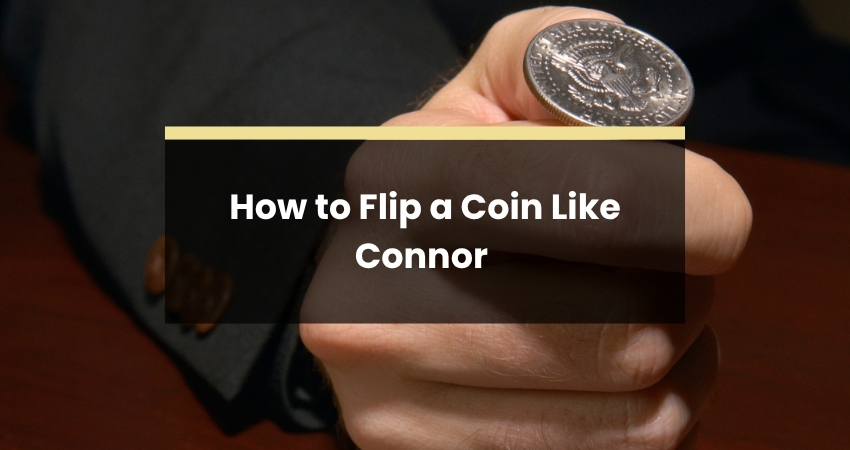How to Flip a Coin Like Connor?
Ever watched Connor from Detroit: Become Human effortlessly flip coins and wondered how he makes it look so smooth? You’re not alone – thousands of gamers have searched for ways to master Connor’s coin flip technique, and honestly, it’s way more achievable than you might think.
This guide breaks down everything you need to know about flipping coins like Connor, from the basic grip that actually matters to those fancy one-handed catches that’ll make your friends do a double-take. By the time you finish reading this, you’ll have all the tools to turn your clumsy coin tosses into something that would make the android detective himself proud.
Who Is Connor and Why Does His Coin Flip Matter?
There’s something almost hypnotic about watching Connor manipulate that quarter – it’s not just showing off, it’s pure technique perfected.
Connor from Detroit: Become Human isn’t just any character throwing coins around randomly. His methodical approach to coin tricks, especially that signature flip and catch combo, has spawned countless YouTube tutorials and Reddit discussions. What makes his technique special isn’t magic – it’s actually solid physics combined with practiced precision that anyone can learn.
The reason Connor’s coin work resonates with so many people goes beyond gaming culture. His flips represent control and confidence, turning something as mundane as a coin toss into a moment of focused skill. Plus, let’s be honest, it just looks incredibly cool when done right.
The Science Behind a Perfect Coin Flip
Getting Connor’s technique down means understanding why coins behave the way they do – and trust me, there’s actual science behind those perfect tosses.
Physics of a Coin Toss
When you flip a coin properly, several forces work together to create that satisfying arc and spin. The initial thumb flick generates angular momentum – basically, how fast and consistently your coin rotates through the air. Think of it like a spinning top, but one that’s also flying.
Gravity pulls the coin back down in a predictable curve, while air resistance subtly affects both the spin rate and flight path. Here’s where it gets interesting though – coins don’t actually have perfectly random outcomes. Research has shown they tend to land on whichever side was facing up when you started the flip about 51% of the time. Not a huge bias, but Connor’s technique actually uses this to its advantage.
The key insight? Consistent form creates consistent results. Master the mechanics, and you’ll get repeatable tosses that look professional every single time.
Factors That Affect Coin Toss Outcomes
Several variables can mess with your Connor-style aspirations if you’re not careful. Room temperature and humidity barely matter for indoor practice, but wind is your enemy if you’re trying to flip outdoors. Even slight breezes can turn a perfect vertical toss into something wobbly and unpredictable.
Your coin’s condition plays a bigger role than most people realize. Scratched or bent coins create turbulence during flight, while clean, flat coins sail through the air smoothly. This is why Connor’s quarter always looks pristine – damaged coins just don’t flip the same way.
The surface where your coin lands also affects the final result. Hard surfaces might cause bouncing that changes the outcome, while soft surfaces like carpet can stop the coin exactly where it first touches down.
Tools You Need to Flip a Coin Like a Pro
You don’t need special equipment to nail Connor’s technique, but using the right coin and getting your grip sorted makes everything easier.
The Ideal Coin
Quarters work perfectly for Connor-style flipping, and there’s good reason he uses one in the game. They’re heavy enough to maintain stable flight patterns but not so heavy that they’re hard to control. The ridged edges also give your fingers better grip contact than smooth-edged coins.
Fresh quarters from the bank work better than pocket change that’s been worn smooth. You want clear, sharp edge details that your thumb can grab onto consistently. For more detailed guidance on choosing the best coin for flipping, consider factors like weight distribution and edge quality.
Some people swear by specific coin years or designs, but honestly, any standard quarter in decent condition will do the job. The technique matters way more than having some “perfect” coin.
Hand Position and Grip
Getting your grip right feels awkward at first, but it’s the foundation everything else builds on. Hold the coin between your thumb and index finger, but not like you’re picking up a piece of paper – you need firm contact without crushing it.
Your thumb should rest against the coin’s edge, not flat against its face. This edge contact gives you maximum control over how fast the coin spins when you release it. For those interested in different finger techniques, learning how to flick a coin with your fingers can complement Connor’s method.
Wrist position matters more than you’d expect. Keep it relaxed but ready to snap upward – think about the motion you’d use to flick water off your fingertips. Tense wrists create jerky tosses, while completely loose wrists don’t generate enough spin.
Step-by-Step Guide: How to Flip a Coin Like Connor
Here’s where theory meets practice – these seven steps will take you from fumbling amateur tosses to Connor-level coin mastery.
Step 1: Choose the Right Coin
Start with a standard quarter that’s in good shape – no dents, major scratches, or wear that’s made the edges smooth. Give it a quick spin on a table to check if it wobbles. Wobbly coins create unpredictable flight patterns that’ll frustrate you while learning.
Clean your practice coin with a soft cloth to remove any oils or grime. This isn’t being obsessive – slippery coins slip out of your grip at the worst possible moments. A clean coin feels more secure in your fingers and provides better tactile feedback.
Test a few different quarters if you have them available. Sometimes one just feels right in your hand, and that’s the one you should stick with for practice sessions.
Step 2: Grip With Precision
Place the coin between your thumb pad and the tip of your index finger. Don’t pinch it like you’re afraid it’ll escape – use firm, confident pressure that keeps the coin stable without requiring constant adjustment.
Position your thumb so it’s perpendicular to the coin’s edge. This maximizes the contact area and gives you the most control over spin direction and speed. Your fingers should form a natural “C” shape around the coin’s edge.
Practice holding the coin in this position without flipping it. Get comfortable with how it feels, and notice how small pressure changes affect your grip security. This foundation work prevents fumbles later.
Step 3: Use Proper Wrist Action
Start with your wrist in a comfortable, neutral position – not bent forward or backward. The flip motion comes from a quick upward snap, similar to shaking water off your hand or flicking a light switch upward.
The snap should feel crisp and controlled, not wild or rushed. Think “quick but smooth” rather than “fast and jerky.” Your wrist should follow through naturally after the coin leaves your thumb, not stop abruptly mid-motion.
Practice the wrist motion without a coin first. Get the muscle memory down for that smooth upward snap, then add the coin once the movement feels automatic.
Step 4: Maintain Vertical Toss Angle
This step separates amateur tosses from Connor-quality flips. Your coin should travel straight up and come straight back down – no horizontal drift that makes catches difficult or looks sloppy.
Focus on releasing the coin directly above your catching position. If your tosses keep drifting left or right, check your grip and wrist angle. Usually, uneven thumb pressure or a tilted release causes directional problems.
Practice against a wall as a backdrop so you can easily see if your tosses are staying vertical. Coins that drift sideways indicate technique issues that need correction before moving to advanced tricks.
Step 5: Control the Height
Aim for 18-24 inches above your hand – high enough for multiple rotations but not so high that tracking becomes difficult. This height range gives you the best combination of visual appeal and catch-ability.
Height control comes from wrist snap intensity, which takes practice to calibrate. Start with gentler tosses and gradually increase force until you find your sweet spot. Consistent height makes everything else easier.
Count rotations as you practice. Good Connor technique achieves 3-4 complete spins within the optimal height range. Too few spins look amateurish, while too many become hard to track visually.
Step 6: Land It Smoothly
Position your catching hand early, directly below where you expect the coin to land. Don’t wait until the last second – early preparation leads to confident, smooth catches that complete the professional look.
Use a soft catching technique where your hand moves slightly downward as the coin makes contact. This absorbs the impact and prevents jarring catches that can bounce the coin away from your hand.
Practice one-handed catches exclusively once you’re comfortable with the basic toss. Two-handed catches look desperate and ruin the smooth Connor aesthetic you’re working toward.
Step 7: Call It Smartly
If you’re flipping for an actual decision, make your call while the coin is at peak height. This gives you time to observe the rotation pattern and shows confidence in your prediction skills. Some people claim to know how to win a coin flip every time, but consistent technique focuses more on presentation than guaranteed outcomes.
Watch the coin’s spin to improve your calling accuracy over time. Faster rotations require quicker visual processing, while slower spins give you more time to track the pattern and make educated guesses.
Remember that even perfect technique can’t guarantee outcomes – the goal is consistent, professional-looking tosses rather than controlling results. The visual presentation matters more than winning coin flips.
Practicing for Consistency
Daily practice sessions beat marathon weekend attempts every time – 15-20 minutes of focused work builds muscle memory faster than hours of mindless repetition.
Work on one element at a time during practice sessions. Spend one day focusing only on grip consistency, the next on height control, then on catch timing. This targeted approach accelerates improvement more than trying to perfect everything simultaneously.
Keep simple stats during practice – successful catches out of 10 attempts, for example. Tracking progress numerically helps identify problem areas and maintains motivation when improvement feels slow.
Video yourself practicing if possible. You’ll spot grip inconsistencies, wrist angle problems, and timing issues that aren’t obvious while you’re performing the technique. Even phone video works fine for this kind of analysis.
Conclusion
Learning how to flip a coin like Connor turns a basic decision tool into genuine skill that impresses people and serves practical purposes. The seven techniques in this guide – proper grip, controlled wrist action, vertical trajectory, and smooth catches – give you everything needed to develop Connor-level coin flipping that combines visual appeal with consistent performance.
The path from clumsy tosses to Connor mastery requires regular practice and patience with the learning process. Start with basic grip and release work, then progress through height control and advanced catching techniques. With consistent effort and attention to these proven methods, you’ll soon flip coins with the same precision and style that made Connor’s techniques legendary among gamers worldwide.






